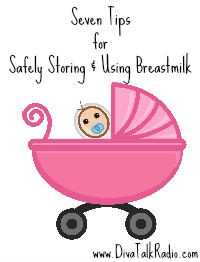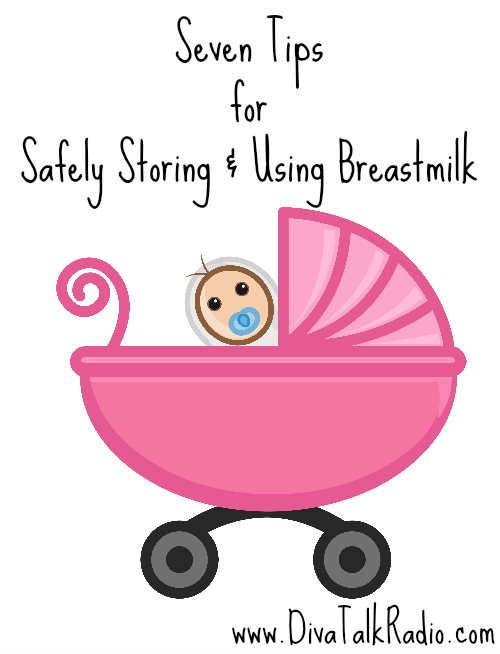 There are all kinds of reasons why moms decide to store their breastmilk. Often, it’s because she needs to return to work; other times, she just wants some flexibility and a break from breastfeeding. Whatever the reason, safe storage and usage tips can help a lot.
There are all kinds of reasons why moms decide to store their breastmilk. Often, it’s because she needs to return to work; other times, she just wants some flexibility and a break from breastfeeding. Whatever the reason, safe storage and usage tips can help a lot.
Here are seven tips for safe breastmilk storage.
1. Pumping Equipment
Keep your pumping equipment clean and dry – wash it immediately after use and let it air-dry.
2. Label and Date
Label and date your storage container – you may think you’ll remember, but no one is perfect! …especially if you store more than one container day after day.
3. Don’t Shake
Have you ever made homemade butter by shaking milk in a jar? You may end up causing a similar separation if you shake or agitate breastmilk too much. To mix it (which is a good idea when you or a caretaker start to use the stored milk to feed baby), gently swirl the milk so the creamy and thin parts are blended.
4. Refrigeration
If the milk will be used within 3 to 5 days, you can simply store it in the refrigerator. After that, you’ll need to freeze it. You can add freshly-expressed milk to the containers in the refrigerator as well, sources say.
5. Freezing
Leave a bit of space at the top of the container before freezing to give the freezing milk room to expand. Also, waiting until the milk is frozen to tighten the container top is also helpful (this allows a bit of air to escape as the milk expands). And finally, store breastmilk toward the back of the freezer so it stays at a more constant temperature.
6. Avoid the Microwave
When re-heating baby’s milk, experts frown on the microwave, as it can create hot spots that can injure your baby. (And if you’re trying to transition from breast to bottle, such a burn may frighten baby away from bottles for some time.) Instead, thaw milk in the refrigerator overnight, or place the container in a pan of warm water.
Some babies have no problem drinking cold or room-temperature breastmilk. But if you want to warm it, place the container in a pan of warm water (change the water from the thawing and replace with fresh warm water). You can also hold the container under warm running water.
7. Containers
The La Leche League warns that containers used to store breastmilk should never contain BPA. Glass or BPA-free hard plastic is recommended. Freezer milk bags manufactured for storing breastmilk are also an option.
No matter what your reasoning is for Breastmilk storage, be sure to utilize these seven tips to keep your supply safe and usable.
That’s it for now. Until next time Divas, wear your heels well and Be Blessed!

P.S. Please join my newsletter in the top right sidebar. Thank you!



 Some of the links on this site are affiliate links. If you click on those links and make a purchase, Kelli Claypool will receive a small commission. This is greatly appreciated as all affiliate income is donated back into our community as part of our Mission 500 Project. Affiliate links contained within a post are noted accordingly.
Some of the links on this site are affiliate links. If you click on those links and make a purchase, Kelli Claypool will receive a small commission. This is greatly appreciated as all affiliate income is donated back into our community as part of our Mission 500 Project. Affiliate links contained within a post are noted accordingly. Please note that Kelli Claypool is not, nor are any of our guest bloggers, Interns, or contributing writers (unless otherwise noted within their bio) certified nutritionists, herbalists, counselors or doctors. Information shared on this website is from our own individual research and/or opinion and is for informational and entertainment purposes only. Please conduct your own diligent research as we cannot be held accountable for any undesirable outcome.
Please note that Kelli Claypool is not, nor are any of our guest bloggers, Interns, or contributing writers (unless otherwise noted within their bio) certified nutritionists, herbalists, counselors or doctors. Information shared on this website is from our own individual research and/or opinion and is for informational and entertainment purposes only. Please conduct your own diligent research as we cannot be held accountable for any undesirable outcome. Thank YOU for being here! Without our readers and loyal listeners, this website would be a very quiet place. Thank YOU for taking the time to read our posts, listen to our shows, and give us your encouraging feedback. Our goal is to support you, to love you, and to inspire you to live victoriously in all areas of your life.
Thank YOU for being here! Without our readers and loyal listeners, this website would be a very quiet place. Thank YOU for taking the time to read our posts, listen to our shows, and give us your encouraging feedback. Our goal is to support you, to love you, and to inspire you to live victoriously in all areas of your life.
Leave a Reply